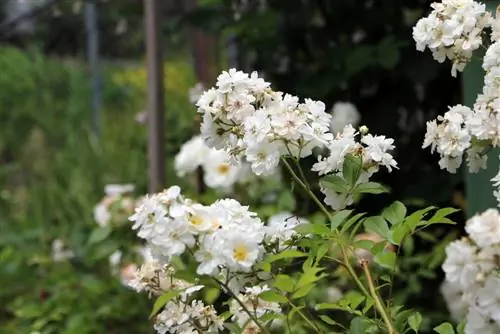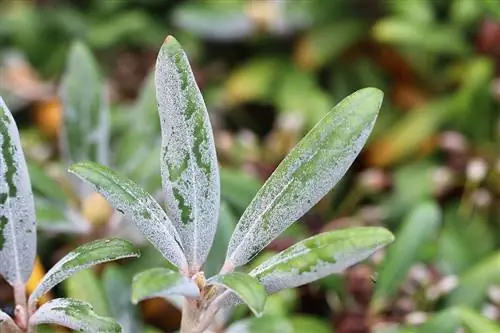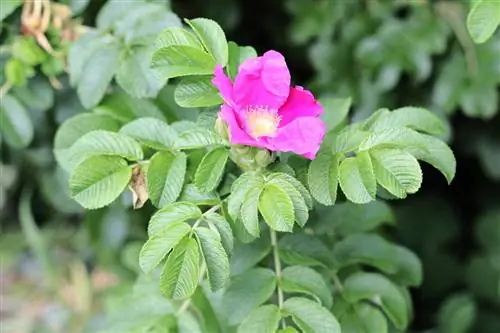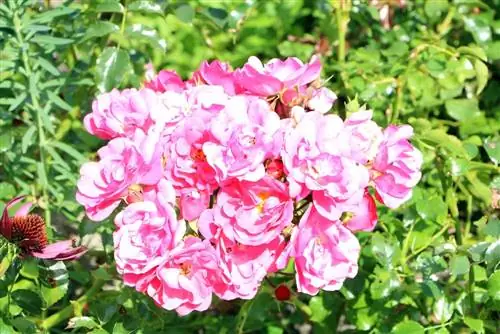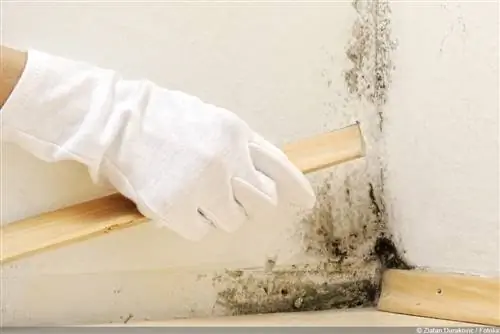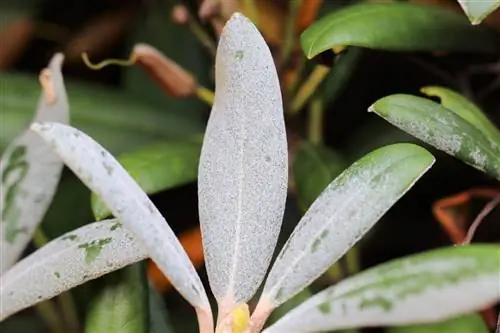- Author admin [email protected].
- Public 2023-12-17 03:39.
- Last modified 2025-06-01 06:48.
There are a variety of measures that can help remove the white coating on the rose petals. However, it is also helpful to make sure in advance that this plant disease does not break out in the first place.
Different types of mildew
If you notice mildew on your roses, you should definitely take a close look. There are two different types of this fungal infestation, which is also called fair-weather fungus. What is the same in both variants, however, is the spread via spores, which form a dense network of very fine fibers on the plant. Experts also call this mycelium.
Both the so-called “powdery mildew” and “downy mildew” form a white to gray fur on the roses, which is particularly visible on the upper side of the leaves. This can simply be wiped off with a damp cloth. However, if the infestation is more pronounced, the buds and the shoot tips are usually also affected and crippled. The leaves of infected rose plants appear bumpy and brown at the tips. This causes the growth of the roses to come to a standstill.
Rapid spread under special climatic conditions
Powdery mildew on roses is particularly noticeable in periods of fine, dry weather, which is, however, accompanied by dew at night. It is therefore clear that sunny days in spring and autumn in particular create the ideal living conditions for this fungal infestation. If nothing has been done to combat this pest until late autumn, dark winter fruiting bodies will form, which can overwinter in leaves and plant debris on the ground.
Downy mildew is not always clearly recognizable
In contrast to the whitish coating of downy mildew, downy mildew mainly forms reddish-purple spots on the upper side of the leaves of the roses. There may be yellow and brown spots on the leaves, which are bordered by leaf veins. On the underside of the leaves, however, a gray fungal coating forms that is soft to the touch. The infestation with downy mildew can reach the point where buds and shoots of roses are also attacked.
In contrast to the warm and dry conditions that downy mildew needs to grow, downy mildew spreads primarily in humid and only moderately warm climates. An excessive nitrogen content in the plant's soil also contributes to the infestation of this pest. If you want to protect yourself against mildew when buying your rose plants, you should make sure that the plant is declared with the wording “against races 1 - 26”. This means that the roses are immune to certain subspecies of the fungus, which continually develops new resistances.
Fighting mildew with simple home remedies
Many garden owners and plant lovers are concerned about protecting their garden from chemical pests in pesticides. If you're worried because your roses are infected with mildew, you can take action with simple home remedies:
- Milk has proven to be particularly effective here, with fresh milk being used in particular.
- You simply mix one part milk with nine parts water and spray this mixture at close range onto the affected plants.
- The microorganisms contained in milk are usually very successful in combating fungal infestation, which makes it clear why it has to be fresh milk and why long-life milk is not suitable for use.
- The lecithin contained in the milk is effective against mildew and the sodium phosphate strengthens the defenses of the rose plant.
- This achieves two important results with a relatively simple measure that should be carried out approximately two to three times a week if necessary.
Further precautions are recommended
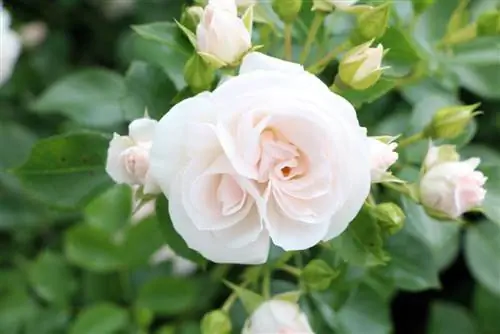
In general, the natural resistance of the rose plant offers the best protection against fungal attack. There are already many varieties, especially of bed and shrub roses, but also of ground-cover varieties, that have a low susceptibility to pests such as powdery mildew. Anyone who prefers to rely on noble roses and tea hybrids must know that resistance breeding is still in its infancy in these genera and individual measures must therefore be taken by the garden owner himself. Generally recommended:
- regular removal of plant residues
- Separation of infected plant parts and safe disposal
- Clean garden tools or growth aids just as meticulously, preferably with an antiseptic
- Always wear gloves when treating diseased roses
- apply chemical pesticides only directly to the diseased rose
Prevention is better than treatment
As in many other areas, the principle that applies to the he althy and beautiful growth of roses in the garden is that prevention is more effective than the best pesticide after the fact. You can take precautions when selecting plants by thinking carefully about the soil and sun conditions at the planting location.
In addition to regular care and fertilization, the plants should also be regularly pruned, as this is a beneficial measure for the he alth and growth of the plant and does not look nearly as radical as a diseased plant cut or to remove infected plant parts. The rose in particular has a very difficult and slow recovery from this.
With individual care tips and observing rose growth and flower development, harmful infestations such as powdery mildew can be prevented. This not only saves time and money for control, but also enables the rose to have a long, he althy lifespan, which rewards it with wonderful flowers in all colors.
What you should know about rose mildew in brief
- Mildew is a collective name for various plant diseases caused by fungi.
- It usually appears as a white coating, the so-called fungal turf, on the leaf surfaces.
A distinction is made between powdery mildew and downy mildew: The pathogens of powdery mildew belong to the ascomycetes and mainly attack leaves. First the leaves are covered with a flour-like coating and later turn brown until they dry up and fall off. Downy mildew is a fungus and penetrates the plant. It is shown by a white coating on the underside of the leaves.
- In agriculture and horticulture, fungicides of chemical structure are used against the various types of mildew.
- The powdery mildew fungus is usually used with a sulfur-based pesticide.
While powdery mildew is harmful to plants, an intact ecosystem requires powdery mildew, for example for some species of ladybirds. The sixteen-spotted, twenty-two-spotted and sixteen-spotted ladybirds feed exclusively on powdery mildew, making this plant disease vital to these species.
In German gardens, roses in particular are affected by powdery mildew. Very sensitive rose varieties can be severely weakened by this disease. The fungal spores spread through the wind and require moist leaves to germinate. The formation of dew at night is usually sufficient for this.
- To prevent mildew infestation, roses should only be planted in moist, nutrient-rich soil in a sunny location.
- The soil should be particularly rich in potassium, as this strengthens the roses' defenses.
- Furthermore, susceptible roses should be kept as bright as possible and watered as little as possible.
- You should strengthen the plants with fertilizer and repot them in a fresh container.
- The leaves should definitely be kept dry and therefore protected from rain.
An old home remedy for mildew is baking soda and oil mixed together and dusted on the plant. Mix three packets of baking soda with 50 ml of cooking oil and add a few squirts of dishwashing liquid as an emulsifier and spray endangered plants with it in the evening every ten to 14 days. The floury coating quickly disappears and what still looks damaged after a few days can simply be cut out.
Basically, you need a lot of patience to combat mildew, although you shouldn't wait too long if an infestation occurs, as the rose will quickly weaken and wilt.

